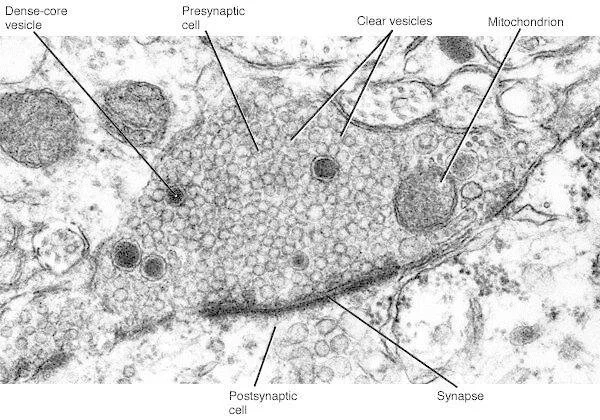Answer: Clear vesicles store appear as light or transparent under an electron microscope, while dense core vesicles appear dark.
Vesicles are small packages of cell membranes that neurons use in order to regulate the release of neurotransmitters into the synapse. Within each vesicle is contained several molecules of neurotransmitters.
Vesicles can be classified into categories depending on their physical properties.
Vesicle size
Clear vesicles are often also called "small vesicles" because, as expected, they are the smallest of the types of vesicles. They have an average diameter of about 40 nanometers.
Dense core vesicles are much larger. They range in diameter from 100 to 250 nanometers.
Contents of synaptic vesicles
Small clear synaptic vesicles generally contain neurotransmitters such as GABA or glutamate.
Dense core vesicles usually contain larger neurotransmitter molecules, such as neuropeptides like enkephalin or dynorphin.
Biogenic amines, such as dopamine or serotonin, can be stored in small, dense core vesicles or large dense core vesicles. The mature of the vesicles depends on the population of neurons.
Filling of synaptic vesicles
Clear vesicles are filled with neurotransmitter by the action of vesicular transmembrane proteins called transporters. These transporters are specific for a class of molecules that they are able to transport. For example, a vesicular acetylcholine transporter (VAChT) can move molecules of acetylcholine into the vesicles, while a vesicular glutamate transporter (VGluT) moves molecules of glutamate. These transporters require that protons of H+ are pumped opposite of the movement of the neurotransmitter molecules. Therefore, vesicular transporters fall into the category of antiporters.
Large dense core vesicles are packaged at or near the nucleus. Because of this, they do not use transporter proteins, but instead are filled after synthesis of the peptide.
Release conditions
Clear vesicles are stored in one of three "pools" of vesicles. The ones that are closest to the membrane are partially docked, meaning that the vesicular coat proteins (V-SNAREs) are already beginning to interact with the proteins on the inside of the cell membranes (T-SNAREs). These vesicles are called the "readily releasable pool". When an action potential travels down the axon and reaches the terminal, voltage gated calcium channels open, which allow for vesicle fusion.
Dense core vesicles are usually released during high frequency trains of activity.
